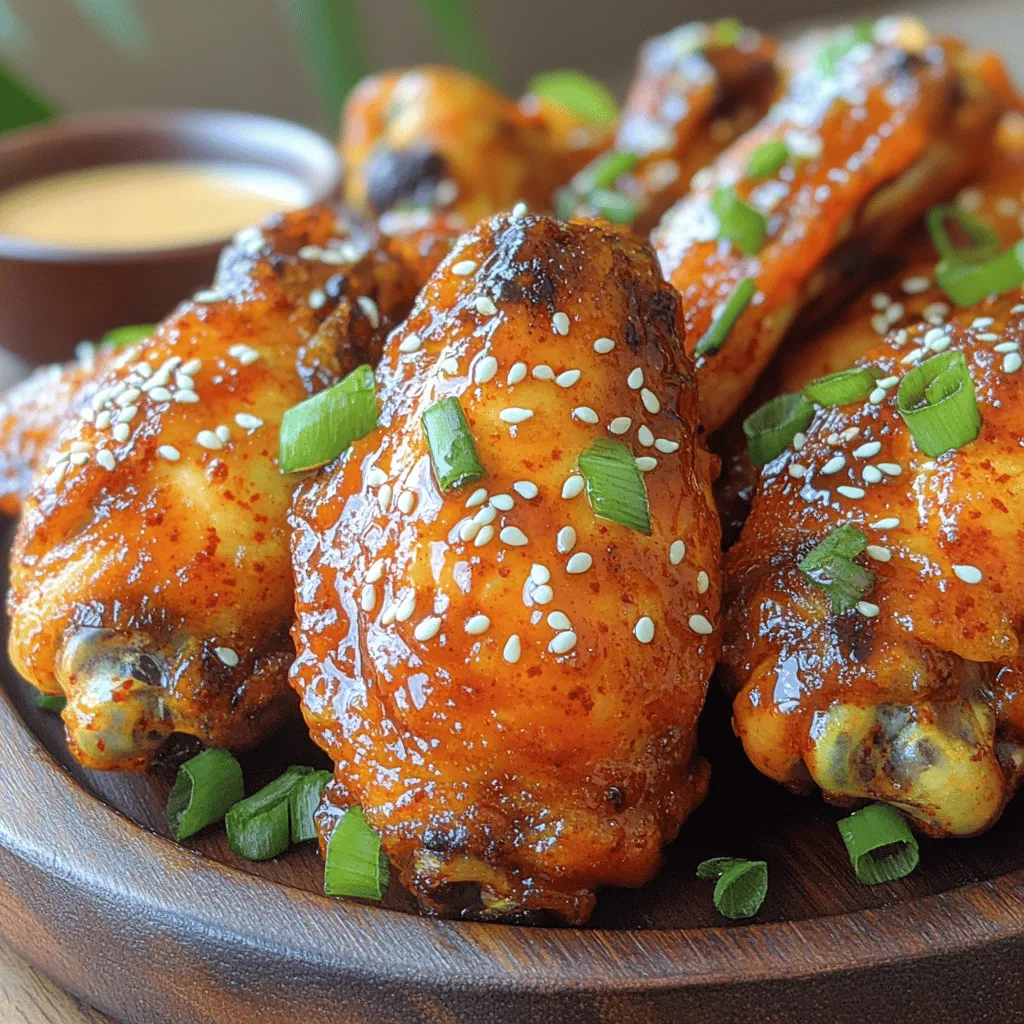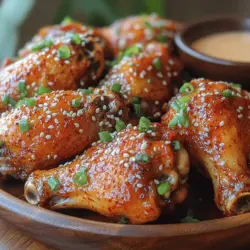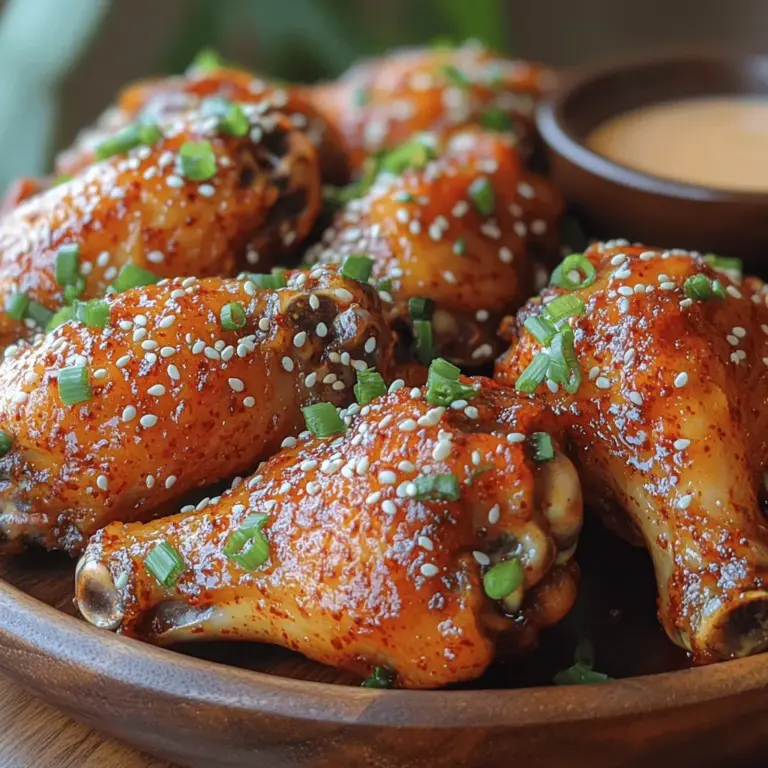Introduction
Korean fried chicken has taken the culinary world by storm, captivating food lovers with its irresistible crunch and succulent meat. With its origins rooted in the bustling streets of Seoul, this beloved dish has evolved into a global sensation, often enjoyed at gatherings, celebrations, or simply as a treat to indulge in. The secret to its rising popularity lies not just in its delightful taste, but in the art of achieving the perfect crispy texture combined with a flavorful sauce that tantalizes the taste buds.
Introducing “Crispy Korean Delight,” a recipe that showcases the best of Korean fried chicken. This dish is not only about the crunch; it is a harmonious blend of flavors and textures that come together to create a memorable dining experience. From the first bite, you’ll experience the crispiness of the chicken skin, followed by tender meat that bursts with vibrant flavors from the unique sauce. Whether you are hosting a dinner party or simply craving comfort food, this recipe is sure to impress.
Understanding the Ingredients
To create the perfect Crispy Korean Delight, understanding the role of each ingredient is crucial. Here, we break down the key components that bring this dish to life.
Chicken Wings or Drumsticks
When it comes to fried chicken, opting for chicken wings or drumsticks is the best choice. These cuts have the ideal amount of fat and connective tissue, ensuring a juicy and flavorful bite. Their shape also allows for even cooking, resulting in a crispy exterior while maintaining a tender interior. For those seeking a more substantial portion, drumsticks can be particularly satisfying, whereas wings are perfect for snacking or sharing.
All-Purpose Flour and Cornstarch
Creating that signature crispiness involves a careful balance between all-purpose flour and cornstarch. The flour provides the structure, while cornstarch enhances the crunch factor. When combined, these two ingredients form a dry batter that adheres beautifully to the chicken, allowing for an even coating that fries to a golden perfection. This combination is essential in achieving that iconic texture that Korean fried chicken is known for.
Gochujang
No Korean dish would be complete without gochujang, the beloved Korean chili paste that adds depth and heat. This fermented seasoning is a staple in Korean kitchens, providing a unique flavor profile that is both spicy and slightly sweet. Not only does gochujang enhance the overall taste of the chicken, but it also contributes to the vibrant red hue that makes this dish visually appealing. Incorporating this ingredient is key to achieving an authentic Korean flavor that elevates the dish from ordinary to extraordinary.
Honey
To balance the heat from the gochujang, honey is an essential ingredient that adds a touch of sweetness. This natural sweetener not only complements the spiciness but also contributes to the glossy finish of the sauce. The caramelization of honey during the frying process enhances the overall flavor, creating a delightful contrast to the savory elements of the dish.
Soy Sauce and Rice Vinegar
Adding depth and tang to the flavor profile is achieved through the use of soy sauce and rice vinegar. Soy sauce introduces a rich umami flavor, while rice vinegar brings a subtle acidity that cuts through the richness of the chicken. Together, these ingredients create a balanced taste that is both savory and slightly tangy, making each bite a delightful experience.
Preparing the Chicken
The preparation of the chicken is crucial to ensure maximum flavor and tenderness. Marinating the chicken allows the flavors to penetrate deep into the meat, resulting in a flavorful dish that’s hard to resist.
Rinsing and Seasoning the Chicken
Start by rinsing the chicken pieces under cold water to remove any residual blood or impurities. This step is essential for ensuring cleanliness and enhancing the overall flavor of the dish. After rinsing, pat the chicken dry with paper towels to remove excess moisture, as this will help the coating adhere better during frying.
Next, season the chicken with salt and pepper. This simple yet effective seasoning step ensures that the chicken is well-flavored from the inside out. For an added depth of flavor, consider including minced garlic or ginger at this stage, which will infuse the meat with aromatic notes.
Recommended Marination Time and Conditions
For optimal results, marinate the chicken for at least 30 minutes, although longer is preferable. If time allows, marinating the chicken for several hours or even overnight in the refrigerator can significantly enhance the flavor and tenderness. When marinating, make sure to cover the bowl with plastic wrap or transfer the chicken to a sealed plastic bag to prevent contamination.
Creating the Perfect Dry Batter
The dry batter is the cornerstone of achieving that coveted crispy texture that Korean fried chicken is known for. Here’s how to create the perfect blend.
Components of the Batter
To make the dry batter, combine all-purpose flour, cornstarch, and baking powder in a large bowl. The baking powder plays a crucial role in achieving crunchiness, as it creates air pockets in the batter during the frying process, resulting in a light and crispy coating. The ideal ratio is typically two parts flour to one part cornstarch, but feel free to adjust according to your preferences.
Spice Adjustments for Personal Taste
For those who enjoy a bit of a kick, consider adding cayenne pepper or chili powder to the dry batter. This not only enhances the flavor but also allows you to control the spiciness of the final dish. Start with a small amount and adjust according to your taste preferences, ensuring that the heat complements rather than overwhelms the other flavors.
Mixing Techniques for an Even Texture
When mixing the dry batter, whisk the ingredients together until well combined. This step is vital for ensuring an even distribution of flavors and textures. Avoid overmixing, as this can lead to clumping. The goal is to achieve a light and airy consistency that will adhere to the chicken, creating that signature crispy coating.
Coating the Chicken
Coating the chicken properly is essential for achieving an even and crispy finish. Here are some best practices to follow.
Achieving an Even Coating
To start, take your marinated chicken pieces and dip them into the prepared dry batter. Use one hand for the wet chicken and the other for the dry batter to avoid clumping. Make sure each piece is evenly coated by gently pressing the batter onto the chicken, ensuring that every surface is covered.
Importance of Shaking Off Excess Flour
After coating the chicken, it is important to shake off any excess flour. This step prevents clumping and ensures a crispy finish when fried. Gently tap the chicken against the side of the bowl or use a wire rack to allow excess batter to fall away.
Utilizing a Wire Rack
Placing the coated chicken on a wire rack before frying is a beneficial practice. This allows the batter to set slightly, creating a better adherence to the chicken during frying. The wire rack also prevents the pieces from sticking together and ensures even cooking, as air can circulate around the chicken.
Frying Techniques for Optimal Crispiness
Frying is where the magic happens, transforming the coated chicken into a crispy delight. To achieve optimal crispiness, follow these frying techniques:
1. Oil Temperature: Heat oil in a deep fryer or a heavy-bottomed pot to a temperature between 350°F to 375°F (175°C to 190°C). Maintaining the right oil temperature is crucial; too low, and the chicken will absorb excess oil, resulting in a greasy texture. Too high, and the coating may burn before the chicken cooks through.
2. Batch Cooking: Fry the chicken in small batches to avoid overcrowding the pot. This ensures that the oil temperature remains consistent, allowing for even frying. Overcrowding can lead to uneven cooking and soggy chicken.
3. Frying Time: Depending on the size of the chicken pieces, frying typically takes 8 to 12 minutes. Use a meat thermometer to check the internal temperature, which should reach at least 165°F (75°C) for safe consumption.
4. Draining Excess Oil: After frying, place the chicken on a wire rack or paper towels to drain excess oil. This step is essential to maintain the crispiness of the chicken, preventing it from becoming soggy.
With these foundational steps and insights into the ingredients, you are well on your way to creating a mouthwatering Crispy Korean Delight that will leave your taste buds dancing. As you embark on this culinary adventure, remember that the joy of cooking lies not only in the destination but also in the journey of creating something truly delicious.

The Importance of Oil Temperature: How to Test if Oil is Ready
When it comes to frying chicken, achieving the perfect oil temperature is crucial for a crispy exterior and juicy interior. The ideal frying temperature for chicken is between 350°F to 375°F (175°C to 190°C). If the oil is too cool, the chicken will absorb excess oil, resulting in a greasy texture. Conversely, if the oil is too hot, the outside will burn before the inside is cooked through.
How to Test Oil Temperature:
1. Thermometer Method: The most accurate way is to use a deep-frying thermometer. Place it in the oil, ensuring it does not touch the bottom of the pan.
2. Wooden Spoon Method: If you don’t have a thermometer, you can use a wooden spoon. Dip the handle into the oil; if bubbles form around it, the oil is hot enough for frying.
3. Bread Cube Method: Drop a small piece of bread into the oil. If it browns within 60 seconds, your oil is ready.
Recommended Frying Methods and Equipment
Choosing the right equipment can significantly influence your frying experience. The two most common methods for frying chicken are the deep frying pan and the pot method.
– Deep Frying Pan: A deep frying pan allows for more surface area and ensures that the chicken cooks evenly. It also requires less oil than using a full pot, making it a more economical choice.
– Dutch Oven or Heavy Pot: This method is excellent for maintaining consistent heat. The thick walls of a Dutch oven help retain heat even when adding cold chicken, which is crucial for maintaining the oil temperature.
Tips on Frying in Batches to Ensure Even Cooking:
To achieve perfectly cooked chicken, it’s essential to fry in batches. Overcrowding the pan can lower the oil temperature, leading to uneven frying. Here are some tips:
1. Fry in Small Batches: Depending on your frying equipment, place 3-4 pieces of chicken at a time. This allows for better circulation of oil around the chicken.
2. Monitor Temperature: After each batch, allow the oil to return to the desired temperature before adding more chicken.
3. Use a Slotted Spoon: When removing the chicken, use a slotted spoon to allow excess oil to drain properly, keeping your chicken crispy.
Visual Cues for Perfectly Fried Chicken
Achieving that golden brown color is the hallmark of perfectly fried chicken. Here are some visual cues to look out for:
– Golden Brown Color: The chicken should be a rich golden brown on all sides. This indicates that it has developed a crispy crust without burning.
– Bubbling Oil: As chicken fries, you will notice vigorous bubbling. Once the bubbling subsides, it usually indicates the chicken is nearing doneness.
– Internal Temperature: For safety, always check the internal temperature with a meat thermometer; it should read 165°F (75°C).
Crafting the Flavorful Sauce
The sauce is where the magic happens in Crispy Korean Delight. Here’s how to make it from scratch.
Step-by-Step Process for Making the Sauce:
1. Gather Ingredients: You will need soy sauce, gochujang (Korean chili paste), honey, garlic, ginger, sesame oil, and rice vinegar.
2. Combine Ingredients: In a mixing bowl, add 1/4 cup soy sauce, 2 tablespoons gochujang, 2 tablespoons honey, 3 minced garlic cloves, 1 teaspoon grated ginger, 1 tablespoon sesame oil, and 1 tablespoon rice vinegar.
3. Whisk Together: Mix until all ingredients are well combined and the sauce is smooth.
Importance of Combining Ingredients in the Right Order:
Start with the liquid ingredients (soy sauce and rice vinegar) to help dissolve the paste and honey easily, followed by the solid ingredients. This ensures a cohesive texture.
Cooking Tips for Achieving the Right Consistency:
– If you prefer a thicker sauce, simmer it gently in a saucepan over low heat until it reduces to your desired consistency.
– For a thinner sauce, add a bit of water or chicken broth to adjust.
Flavor Profile Breakdown of the Sauce Ingredients:
– Soy Sauce: Adds umami and saltiness.
– Gochujang: Contributes heat and depth.
– Honey: Balances the spice with sweetness.
– Garlic and Ginger: Introduce aromatic flavors.
– Sesame Oil: Adds a nutty richness.
– Rice Vinegar: Provides acidity to cut through the richness.
Combining Chicken and Sauce
Once your chicken is perfectly fried and your sauce is ready, it’s time to combine the two.
Techniques for Tossing Chicken with Sauce Without Losing Crispiness:
1. Toss Gently: Use a large mixing bowl and carefully add the fried chicken pieces. Pour the sauce over the chicken and gently toss with tongs or a spatula to coat without breaking the crispy crust.
2. Serve Immediately: The longer the chicken sits in the sauce, the less crispy it will become. It’s best served right after tossing.
Visual Presentation Tips for an Appealing Dish:
– Plating: Arrange the chicken pieces neatly on a serving platter, ensuring they are slightly overlapping.
– Drizzle Sauce: Instead of submerging the chicken in sauce, drizzle some sauce over the top for a visually appealing finish.
Garnishing for Presentation
A well-garnished dish not only looks great but also enhances flavor.
Importance of Garnishes:
Garnishes add visual appeal and freshness, elevating the dish from ordinary to extraordinary.
Suggested Garnishes:
– Sesame Seeds: Toasted sesame seeds add a nutty flavor and crunch.
– Chopped Green Onions: Finely chopped green onions provide a pop of color and a mild onion flavor.
Presentation Ideas for Serving at Gatherings or Family Dinners:
– Serve on a large wooden board for a rustic look.
– Use small bowls for the sauce on the side, allowing guests to add more as they like.
Serving Suggestions
Crispy Korean Delight pairs beautifully with various sides.
Pairing Ideas:
– Steamed Rice: A classic accompaniment that soaks up the flavorful sauce.
– Kimchi: Adds a spicy, fermented crunch that complements the dish.
– Pickled Vegetables: Light, tangy pickles balance the richness of the fried chicken.
Best Practices for Enjoying the Chicken While Maintaining Its Crispiness:
– Serve immediately after tossing with sauce to prevent sogginess.
– If necessary, keep fried chicken warm in a low oven (around 200°F) but covered loosely with foil to allow some steam to escape.
Nutritional Information
Understanding what you’re consuming can help balance indulgence with health considerations.
Basic Nutritional Breakdown of the Dish:
– Calories: Approximately 450-500 calories per serving (depending on portion size).
– Protein: About 30g per serving, providing a hearty protein source.
– Fats: Contains around 25g of fat, primarily from frying oil.
Discussion on Moderation and Balance in Enjoying Fried Foods:
While Crispy Korean Delight is a delightful treat, moderation is key. Pair it with fresh vegetables or a salad to increase fiber intake and balance the meal.
Conclusion
Crispy Korean Delight is not just a meal; it’s an experience that brings together the rich flavors and textures of Korean cuisine. The joy of making this dish lies in its simplicity and the satisfaction it brings when shared with family and friends.
Encourage yourself to try this recipe, and relish the vibrant flavors and delightful crunch of homemade fried chicken. There’s a unique satisfaction in creating comfort food from scratch, and Crispy Korean Delight is sure to become a favorite in your culinary repertoire. Enjoy the process, and savor every bite!


